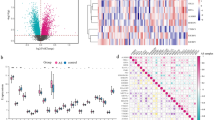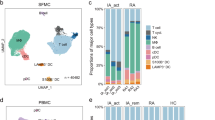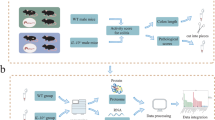Abstract
E3 ligases and RNA-binding protein-mediated dysregulation of proinflammatory cytokines leads to autoimmune and inflammatory diseases. However, whether RNA-binding E3 ligases can regulate specific proinflammatory cytokine expression remains unclear. Here we found that the RNA-binding E3 ligase MKRN2 selectively inhibits the expression of interleukin-6 (IL-6) in lipopolysaccharide-activated macrophages. LysM-Cre+Mkrn2fl/fl mice showed increased amounts of IL-6 in the serum after lipopolysaccharide treatment and exhibited increased severity of experimental colitis, which was associated with increased IL-6. Expression of MKRN2 negatively correlated with expression of IL-6 in clinical samples from individuals with ulcerative colitis and rheumatoid arthritis. Mechanistically, after binding to Il6 messenger RNA, MKRN2 linked K29 polyubiquitin chains to the Lys 179 residue of PAIP1, a translation initiation coactivator, which blocked PAIP1–eIF4A interaction and thus inhibited the translational efficiency of Il6 mRNA. Our findings provide mechanistic insight and potential therapeutic strategies for inflammatory autoimmune diseases by disrupting translation of specific proinflammatory cytokines.
This is a preview of subscription content, access via your institution
Access options
Access Nature and 54 other Nature Portfolio journals
Get Nature+, our best-value online-access subscription
$32.99 / 30 days
cancel any time
Subscribe to this journal
Receive 12 print issues and online access
$259.00 per year
only $21.58 per issue
Buy this article
- Purchase on SpringerLink
- Instant access to full article PDF
Prices may be subject to local taxes which are calculated during checkout







Similar content being viewed by others
Data availability
The microarray (GSE290892), CLIP–seq (GSE289945) and RNA-seq (GSE291859) data have been deposited in the Gene Expression Omnibus. The sequences were mapped to the mm10 reference genome. The authors declare that there are no primary datasets and computer code associated with this study. All data and materials are available to researchers once published. Source data are provided with this paper.
References
Kawai, T. & Akira, S. TLR signaling. Cell Death Differ. 13, 816–825 (2006).
Medzhitov, R. & Horng, T. Transcriptional control of the inflammatory response. Nat. Rev. Immunol. 9, 692–703 (2009).
Taams, L. S. Inflammation and immune resolution. Clin. Exp. Immunol. 193, 1–2 (2018).
Anderson, P. Post-transcriptional control of cytokine production. Nat. Immunol. 9, 353–359 (2008).
Cao, X. Self-regulation and cross-regulation of pattern-recognition receptor signalling in health and disease. Nat. Rev. Immunol. 16, 35–50 (2016).
Zhang, Q. & Cao, X. Epigenetic remodeling in innate immunity and inflammation. Annu. Rev. Immunol. 39, 279–311 (2021).
Smale, S. T. Transcriptional regulation in the innate immune system. Curr. Opin. Immunol. 24, 51–57 (2012).
Liu, J., Qian, C. & Cao, X. Post-translational modification control of innate immunity. Immunity 45, 15–30 (2016).
Liu, J. & Cao, X. RBP–RNA interactions in the control of autoimmunity and autoinflammation. Cell Res. 33, 97–115 (2023).
Carpenter, S., Ricci, E. P., Mercier, B. C., Moore, M. J. & Fitzgerald, K. A. Post-transcriptional regulation of gene expression in innate immunity. Nat. Rev. Immunol. 14, 361–376 (2014).
Iwasaki, H. et al. The IκB kinase complex regulates the stability of cytokine-encoding mRNA induced by TLR–IL-1R by controlling degradation of regnase-1. Nat. Immunol. 12, 1167–1175 (2011).
Akira, S. & Maeda, K. Control of RNA stability in immunity. Annu. Rev. Immunol. 39, 481–509 (2021).
Zinngrebe, J., Montinaro, A., Peltzer, N. & Walczak, H. Ubiquitin in the immune system. EMBO Rep. 15, 28–45 (2014).
van Gent, M., Sparrer, K. M. J. & Gack, M. U. TRIM proteins and their roles in antiviral host defenses. Annu. Rev. Virol. 5, 385–405 (2018).
Jiang, X. & Chen, Z. J. The role of ubiquitylation in immune defence and pathogen evasion. Nat. Rev. Immunol. 12, 35–48 (2011).
Leppek, K. et al. Roquin promotes constitutive mRNA decay via a conserved class of stem-loop recognition motifs. Cell 53, 869–881 (2013).
Kuniyoshi, K. et al. Pivotal role of RNA-binding E3 ubiquitin ligase MEX3C in RIG-I-mediated antiviral innate immunity. Proc. Natl Acad. Sci. USA 111, 5646–5651 (2014).
Jackson, R. J., Hellen, C. U. & Pestova, T. V. The mechanism of eukaryotic translation initiation and principles of its regulation. Nat. Rev. Mol. Cell Biol. 11, 113–127 (2010).
Wells, S. E., Hillner, P. E., Vale, R. D. & Sachs, A. B. Circularization of mRNA by eukaryotic translation initiation factors. Mol. Cell. 2, 135–140 (1998).
Imataka, H., Gradi, A. & Sonenberg, N. A newly identified N-terminal amino acid sequence of human eIF4G binds poly(A)-binding protein and functions in poly(A)-dependent translation. EMBO J. 17, 7480–7489 (1998).
Craig, A. W., Haghighat, A., Yu, A. T. & Sonenberg, N. Interaction of poly(A)denylate-binding protein with the eIF4G homologue PAIP enhances translation. Nature 392, 520–523 (1998).
Martineau, Y. et al. Poly(A)-binding protein-interacting protein 1 binds to eukaryotic translation initiation factor 3 to stimulate translation. Mol. Cell. Biol. 28, 6658–6667 (2008).
Ahmad, S. Unlocking TH17-cell differentiation. Nat. Rev. Immunol. 6, 793 (2006).
Neurath, M. F. Cytokines in inflammatory bowel disease. Nat. Rev. Immunol. 14, 329–342 (2014).
Kawai, T. & Akira, S. The role of pattern-recognition receptors in innate immunity: update on Toll-like receptors. Nat. Immunol. 11, 373–384 (2010).
Shin, C. et al. MKRN2 is a novel ubiquitin E3 ligase for the p65 subunit of NF-κB and negatively regulates inflammatory responses. Sci. Rep. 7, 46097 (2017).
Niepmann, M. & Gerresheim, G. K. Hepatitis C virus translation regulation. Int. J. Mol. Sci. 21, 2328 (2020).
Dominski, Z. & Marzluff, W. F. Formation of the 3′ end of histone mRNA: getting closer to the end. Gene 396, 373–390 (2007).
Bilinski, C., Burleson, J. & Forouhar, F. Inflammation associated with neoplastic colonic polyps. Ann. Clin. Lab. Sci. 42, 266–270 (2012).
Zhang, Q. & Cao, X. Epigenetic regulation of the innate immune response to infection. Nat. Rev. Immunol. 19, 417–432 (2019).
Hunter, C. & Jones, S. IL-6 as a keystone cytokine in health and disease. Nat. Immunol. 16, 448–457 (2015).
Mosteiro, L., Pantoja, C., de Martino, A. & Serrano, M. Senescence promotes in vivo reprogramming through p16INK4a and IL-6. Aging Cell 17, e12711 (2018).
Hao, X. et al. TXNRD1 drives the innate immune response in senescent cells with implications for age-associated inflammation. Nat. Aging 4, 185–197 (2024).
Warde, K. M. et al. Senescence-induced immune remodeling facilitates metastatic adrenal cancer in a sex-dimorphic manner. Nat. Aging 3, 846–865 (2023).
Choe, J. et al. mRNA circularization by METTL3–eIF3h enhances translation and promotes oncogenesis. Nature 561, 556–560 (2018).
Roy, G. et al. PAIP1 interacts with poly(A) binding protein through two independent binding motifs. Mol. Cell. Biol. 22, 3769–3782 (2022).
Beck, D. B., Werner, A., Kastner, D. L. & Aksentijevich, I. Disorders of ubiquitylation: unchained inflammation. Nat. Rev. Rheumatol. 18, 435–447 (2022).
Wang, L. et al. MKRN2 knockout causes male infertility through decreasing STAT1, SIX4, and TNC expression. Front. Endocrinol. 14, 1138096 (2023).
Liu, Z. et al. MKRN2 inhibits the proliferation of gastric cancer by downregulating PKM2. Aging 14, 2004–2013 (2022).
Zhang, Y., Cui, N. & Zheng, G. Ubiquitination of P53 by E3 ligase MKRN2 promotes melanoma cell proliferation. Oncol. Lett. 19, 1975–1984 (2020).
Yang, P. H. et al. Makorin-2 is a neurogenesis inhibitor downstream of phosphatidylinositol 3-kinase/AKT (PI3K/AKT) signal. J. Biol. Chem. 283, 8486–8495 (2008).
Cheung, W. K. et al. Identification of protein domains required for makorin-2-mediated neurogenesis inhibition in Xenopus embryos. Biochem. Biophys. Res. Commun. 394, 18–23 (2010).
Wolf, E. J. et al. MKRN2 physically interacts with GLE1 to regulate mRNA export and zebrafish retinal development. Cell Rep. 31, 107693 (2020).
Zhao, W., Liu, M. & Kirkwood, K. L. p38a stabilizes interleukin-6 mRNA via multiple AU-rich elements. J. Biol. Chem. 283, 1778–1785 (2008).
Paschoud, S. et al. Destabilization of interleukin-6 mRNA requires a putative RNA stem-loop structure, an AU-rich element, and the RNA-binding protein AUF1. Mol. Cell. Biol. 26, 8228–8241 (2006).
Yang, M. et al. K33-linked polyubiquitination of Zap70 by Nrdp1 controls CD8+ T cell activation. Nat. Immunol. 16, 1253–1262 (2015).
Zhang, Q. et al. Tet2 is required to resolve inflammation by recruiting Hdac2 to specifically repress IL-6. Nature 525, 389–393 (2015).
Yu, Z. et al. Lys29-linkage of ASK1 by Skp1–Cullin 1–Fbxo21 ubiquitin ligase complex is required for antiviral innate response. eLife 5, e14087 (2016).
Blue, S. M. et al. Transcriptome-wide identification of RNA-binding protein binding sites using seCLIP–seq. Nat. Protoc. 17, 1223–1265 (2022).
Lu, D. et al. The phosphatase DUSP2 controls the activity of the transcription activator STAT3 and regulates TH17 differentiation. Nat. Immunol. 16, 1263–1273 (2015).
Zhao, R. et al. Nucleophosmin 1 promotes mucosal immunity by supporting mitochondrial oxidative phosphorylation and ILC3 activity. Nat. Immunol. 25, 1565–1579 (2024).
Acknowledgements
We thank J. Liu and Y. Gu (Naval Medical University) for helpful suggestions. We thank X. Zhang (Suzhou Institute of Systems Medicine) for providing the Psicheck2 reporter vector. This work is supported by grants from the National Natural Science Foundation of China (82388201, 32370929 and 32300725), CAMS Innovation Fund for Medical Sciences (2024-I2M-ZD-005, 2023-I2M-2-010 and 2022-I2M-2-004), The NCTIB Fund for R&D Platform for Cell and Gene Therapy, The Suzhou Municipal Key Laboratory (SZS2023005), Doctoral Program of Entrepreneurship and Innovation in Jiangsu Province (2020-30083).
Author information
Authors and Affiliations
Contributions
X.C. supervised the experiments. Z.Y., X.L., J.H., J.P., J.C., P.L., M.Y., Y.Z., J.W. and Q.Z. performed the experiments and analyzed the data. T.C., M.W. and C.W. provided reagents. J.L., X.Z., T.H. and Y.X. provided clinical samples. Z.Y., X.L. and X.C. analyzed the data and wrote the paper.
Corresponding authors
Ethics declarations
Competing interests
The authors declare no competing interests.
Peer review
Peer review information
Nature Immunology thanks Tadamitsu Kishimoto and the other, anonymous, reviewer(s) for their contribution to the peer review of this work. Primary Handling Editor: Ioana Staicu, in collaboration with the Nature Immunology team.
Additional information
Publisher’s note Springer Nature remains neutral with regard to jurisdictional claims in published maps and institutional affiliations.
Extended data
Extended Data Fig. 1 Establishment of Mkrn2 conditional knockout mice.
Strategy to establish Mkrn2flox/flox mice.
Extended Data Fig. 2 MKRN2 does not affect the mRNA levels of innate immune cytokines.
a, Quantification of the mRNA levels of Il6, Tnf and Ifnb1 by Q-PCR in Mkrn2+/+ and Mkrn2−/− BMDMs treated with LPS (100 ng/ml) for 0, 2, 4, 8, 12, or 24 h as indicated (n = 3). b, ELISA showing the concentrations of IL-6, TNF and IFN-β in the supernatants of Mkrn2+/+ and Mkrn2−/− DCs treated with LPS (100 ng/ml) for 0, 4, 8, or 12 h (n = 3). c, Quantification of the mRNA levels of Il6, Tnf and Ifnb1 by Q-PCR in Mkrn2+/+ and Mkrn2−/− DCs treated with LPS (100 ng/ml) for 0, 2, 4, 8, 12, or 24 h as indicated (n = 3). Results are presented as mean ± SD of three biological replicates (one-way ANOVA followed by Bonferroni multiple comparison). n.s. not significant; ****P < 0.0001.
Extended Data Fig. 3 Six months old mice with conditional knock out of Mkrn2 in myeloid cells develop autoinflammation.
a, H&E staining of the liver, lung, and colon tissues from 6 months old LysM-Cre−Mkrn2fl/fl, LysM-Cre+Mkrn2fl/fl, LysM-Cre+Mkrn2fl/flIl6−/− or LysM-Cre+Mkrn2fl/fl mice intraperitoneal injection with 50 μg anti-IL-17A neutralizing antibody. Scale bars, 200 µm. b, Quantification of the numbers of inflammatory cell foci in Liver and Lung tissues (n = 4). Quantification of the area of inflammatory cell foci by imageJ in colon tissues (n = 4). Results are presented as mean ± SD in b. The P values were calculated using one-way ANOVA followed by Bonferroni multiple comparison (b).
Extended Data Fig. 4 MKRN2 had no effect on p65 protein level.
Immunoblot showing the expression of MKRN2 in whole-cell extracts (WCE), nuclear (Nuc) and cytosolic (Cyto) extracts of BMDMs (a) and DCs (b) treated with LPS (100 ng/ml) for for 0, 1, 2, 4, 8, 24 h as indicated.
Extended Data Fig. 5 MKRN2 deficiency increased the polysome/subpolysome ratio of RPL7 and RPS6.
Immunoblot showing the expression of RPL7 and RPS6 in polysome profiling fraction of cell lysates from Mkrn2+/+ and Mkrn2−/− BMDMs treated with LPS (100 ng/ml) for 12 h and subsequent treatment with cycloheximide (CHX; 100 μg/ml) for 15 min. Corresponding quantifications of RPL7 and RPS6 compared to β-actin by ImageJ were shown below (n = 3). Results are presented as mean ± .SD. The P values were calculated using one-way ANOVA followed by Bonferroni multiple comparison.
Extended Data Fig. 6 The RNA-seq results and KEGG enrichment of Mkrn2+/+ and Mkrn2−/− BMDMs.
a, the heatmap of RNA-seq of whole cell extracts derived RNA in Mkrn2+/+ and Mkrn2−/− BMDMs treated with LPS (100 ng/ml) for 12 h. b, the top 30 of pathway enrichment according to (a). c, the heatmap of polysome/sub-polysome FPKM ratio of RNA derived from polysome fraction and sub-polysome fraction in Mkrn2+/+ and Mkrn2−/− BMDMs treated with LPS (100 ng/ml) for 12 h and subsequently treated with CHX (100 μg ml–1) for 15 min. d, the top 30 of pathway enrichment according to (c).
Extended Data Fig. 7 MKRN2 promotes the ubiquitination of PAIP1.
a, top 25 interactants of MKRN2 in STRING database. b,c Immunoblot showing the level of HA, Flag and Myc in the lysates immunoprecipitated with anti-Myc Sepharose Beads of HEK293T cell transiently transfected with Flag-tagged MKRN2, Myc-tagged PABPC1 (b), Myc-tagged PAIP1 (c) and HA-tagged Ub vectors as indicated for 48 h.
Extended Data Fig. 8 MKRN2 form complex with PABPC1, PAIP1 in an Il6 mRNA dependent manner.
Immunoblot showing the level of GST and His fusion protein in GST pull-down complex. 1 μg GST or GST-MKRN2 was co-incubated with 1 μg recombinant His-PAIP1, His-PABPC1 and Il6 transcript for 4 h as indicated. Sepharose 4B beads were then used to pull down the GST complex.
Extended Data Fig. 9 MKRN2 does not affect the half-life of PAIP1.
a,b,c, Immunoblot showing the MKRN2 and PAIP1 levels in Mkrn2+/+ and Mkrn2−/− BMDMs treated with actinomycin D (Act D, 10 μM) (a), Cycloheximide (CHX, 10 μM) (b) or MG132 (10 μM) (c) for 0, 4, 8 h.
Extended Data Fig. 10 Model showing the role of MKRN2 in the regulation of IL-6 translation in homeostasis and inflammation resolution.
MKRN2 binds to the 3’ UTR of Il6 transcript and links the K29 poly-ubiquitin chain onto PAIP1 which disrupt the interaction between PAIP and eIF4A thus inhibit the closed-loop formation and subsequent translational initiation and maintenance of Il6 mRNA. Mkrn2 deficiency will increase the translational efficiency of IL-6 and lead to inflammation.
Supplementary information
Supplementary Tables 1-6
Supplementary Tables 1–6.
Source data
Source Data Fig. 1
Statistical source data.
Source Data Fig. 2
Statistical source data.
Source Data Fig. 3
Statistical source data.
Source Data Fig. 4
Statistical source data.
Source Data Fig. 5
Statistical source data.
Source Data Fig. 6
Statistical source data.
Source Data Fig. 7
Statistical source data.
Source Data Extended Data Fig. 2
Statistical source data.
Source Data Extended Data Fig. 3
Statistical source data.
Source Data Extended Data Fig.5
Statistical source data.
Source Data Figs. 1 and 3–6 and Extended Data Figs. 4, 5 and 7–9
Unprocessed western blots and gels.
Rights and permissions
Springer Nature or its licensor (e.g. a society or other partner) holds exclusive rights to this article under a publishing agreement with the author(s) or other rightsholder(s); author self-archiving of the accepted manuscript version of this article is solely governed by the terms of such publishing agreement and applicable law.
About this article
Cite this article
Yu, Z., Li, X., Huang, J. et al. The RNA-binding E3 ligase MKRN2 selectively disrupts Il6 translation to restrain inflammation. Nat Immunol 26, 1036–1047 (2025). https://doi.org/10.1038/s41590-025-02183-x
Received:
Accepted:
Published:
Issue date:
DOI: https://doi.org/10.1038/s41590-025-02183-x



